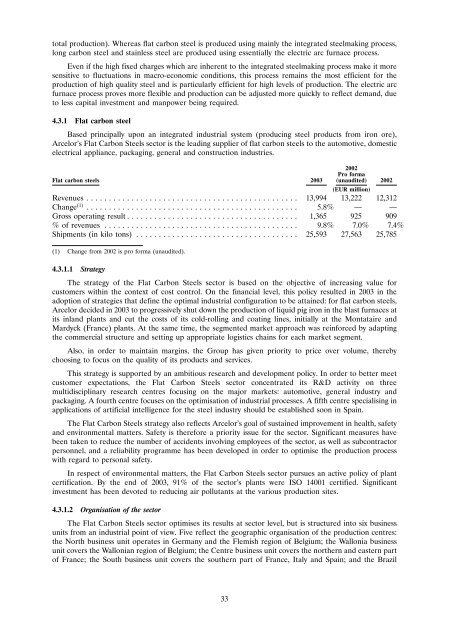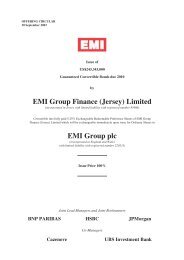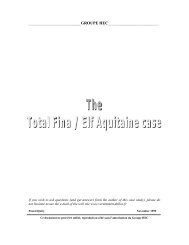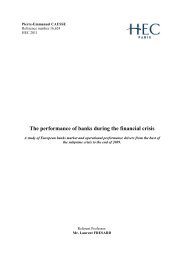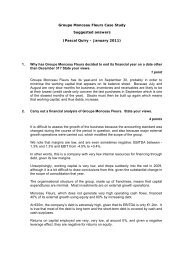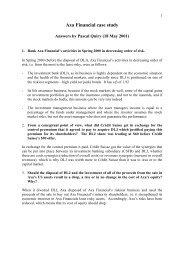Arcelor's capital increase - Vernimmen
Arcelor's capital increase - Vernimmen
Arcelor's capital increase - Vernimmen
You also want an ePaper? Increase the reach of your titles
YUMPU automatically turns print PDFs into web optimized ePapers that Google loves.
total production). Whereas flat carbon steel is produced using mainly the integrated steelmaking process,<br />
long carbon steel and stainless steel are produced using essentially the electric arc furnace process.<br />
Even if the high fixed charges which are inherent to the integrated steelmaking process make it more<br />
sensitive to fluctuations in macro-economic conditions, this process remains the most efficient for the<br />
production of high quality steel and is particularly efficient for high levels of production. The electric arc<br />
furnace process proves more flexible and production can be adjusted more quickly to reflect demand, due<br />
to less <strong>capital</strong> investment and manpower being required.<br />
4.3.1 Flat carbon steel<br />
Based principally upon an integrated industrial system (producing steel products from iron ore),<br />
Arcelor’s Flat Carbon Steels sector is the leading supplier of flat carbon steels to the automotive, domestic<br />
electrical appliance, packaging, general and construction industries.<br />
2002<br />
Pro forma<br />
Flat carbon steels 2003 (unaudited) 2002<br />
(EUR million)<br />
Revenues ............................................... 13,994 13,222 12,312<br />
Change (1) ............................................... 5.8% — —<br />
Gross operating result ...................................... 1,365 925 909<br />
% of revenues ........................................... 9.8% 7.0% 7.4%<br />
Shipments (in kilo tons) .................................... 25,593 27,563 25,785<br />
(1) Change from 2002 is pro forma (unaudited).<br />
4.3.1.1 Strategy<br />
The strategy of the Flat Carbon Steels sector is based on the objective of increasing value for<br />
customers within the context of cost control. On the financial level, this policy resulted in 2003 in the<br />
adoption of strategies that define the optimal industrial configuration to be attained: for flat carbon steels,<br />
Arcelor decided in 2003 to progressively shut down the production of liquid pig iron in the blast furnaces at<br />
its inland plants and cut the costs of its cold-rolling and coating lines, initially at the Montataire and<br />
Mardyck (France) plants. At the same time, the segmented market approach was reinforced by adapting<br />
the commercial structure and setting up appropriate logistics chains for each market segment.<br />
Also, in order to maintain margins, the Group has given priority to price over volume, thereby<br />
choosing to focus on the quality of its products and services.<br />
This strategy is supported by an ambitious research and development policy. In order to better meet<br />
customer expectations, the Flat Carbon Steels sector concentrated its R&D activity on three<br />
multidisciplinary research centres focusing on the major markets: automotive, general industry and<br />
packaging. A fourth centre focuses on the optimisation of industrial processes. A fifth centre specialising in<br />
applications of artificial intelligence for the steel industry should be established soon in Spain.<br />
The Flat Carbon Steels strategy also reflects Arcelor’s goal of sustained improvement in health, safety<br />
and environmental matters. Safety is therefore a priority issue for the sector. Significant measures have<br />
been taken to reduce the number of accidents involving employees of the sector, as well as subcontractor<br />
personnel, and a reliability programme has been developed in order to optimise the production process<br />
with regard to personal safety.<br />
In respect of environmental matters, the Flat Carbon Steels sector pursues an active policy of plant<br />
certification. By the end of 2003, 91% of the sector’s plants were ISO 14001 certified. Significant<br />
investment has been devoted to reducing air pollutants at the various production sites.<br />
4.3.1.2 Organisation of the sector<br />
The Flat Carbon Steels sector optimises its results at sector level, but is structured into six business<br />
units from an industrial point of view. Five reflect the geographic organisation of the production centres:<br />
the North business unit operates in Germany and the Flemish region of Belgium; the Wallonia business<br />
unit covers the Wallonian region of Belgium; the Centre business unit covers the northern and eastern part<br />
of France; the South business unit covers the southern part of France, Italy and Spain; and the Brazil<br />
33


